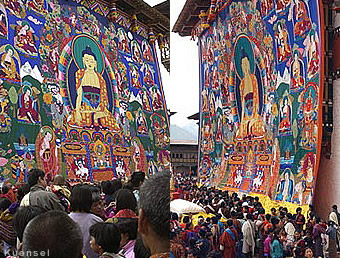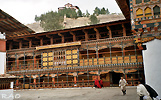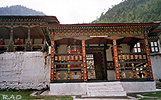 |
Bhutan Festivals |
|
 |
Bhutan Festivals |
|
|
 |
| Bhutanese
Festivals: October - A month of festivity in western dzongkhags |
For
the people of the western dzongkhags of Thimphu, Paro, Haa and Wangdue
Phodrang, October is the busiest and exciting month. It is a month
of lucrative business as well. Apart from the Dromchoes and Tshechus,
fete, and sports meet, various forms of entertainment such as Bhutanese
feature films, exhibitions, song competition, food and folk music festival
are planned this month.
 |
| Several
thousand devotees are attending the Lham Tsomo dance, a highlight
of the 15-day annual Thimphu Domchoe festival, in the courtyard
of Tashichhodzong.
Led
by His Holiness the Je Khenpo, the annual Lhamoi Drupchen (domchoe) is a rite performed for Pelden Lhamo (Mahakali), one of the three
main spiritual protectors of the Drukpa Kagyue school of Buddhism.
The Drupchen was instituted some time between 1705 and 1709 by Kuenga Gyaltshen, the first reincarnation of Jampel Dorji,
the son of Shabdrung Ngawang Namgyal. |
|
According
to legend, Pelden Lhamo appeared before him and performed the dances
while he was in meditation. Based on these dances, Kuenga Gyeltshen initiated the Drupchen. The Thimphu Tshechu was introduced in 1687 during the reign of the fourth Desi, Tenzin Rabgye.
The
annual Phurpai Drupchen (Vajra tradition) ceremony at the National Memorial
Chorten concludes with the Nguedup Langwa (receiving of spiritual
wisdom/power) in the morning and Jinseg (a sacred fire offering) later in the day.
The
eight-day ceremony is being performed in three groups led by three lams,
including the Thimphu Chorten Lam. The Phurpai Drupchen was
started in 1974 and became an annual ceremony in 1981. |
|
 |
top
The Paro
Drupchen is dedicated to Yeshey Goenpo or Mahakala, the protecting
deity of Bhutan. The Gonpoi Drupchen was introduced in Paro,
Wangduephodrang and Trongsa by the 68th Je Khenpo, His Holiness
Tenzin Dendup, in 1987 for the well being of the country.
All
the government offices under Paro dzongkhag remained closed on the occasion
of Paro Domchoe. |
|
 |
top
 Haa
Tshechu Haa
Tshechu |
| The
Haa valley also saw a heap of activities over the past week starting with
the IMTRAT mela followed by the three-day dance festival, Haa Tshechu.
The Haa Tshechu, which was introduced in 1990,
began with the unfurling of the Guru Thongdrel. Only two years ago
the Haa Rabdey was taking dancers from Paro and Thimphu but now
has its own dancers. The Haa rabdey was established in 1983 in the Lhakhang Karpo. |
|
 |
The
spirit of celebration during the Tshechu holidays will not confined
to western dzongkhags alone with Bhutan's Hindu community celebrating the Dashain on October. The Dashain, which symbolises the victory of good over evil,
was declared a national holiday in Bhutan by His Majesty the
King in 1980.
| Information on Bhutan |
 |
|







